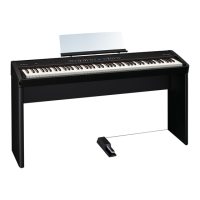Performing
Adjusting the Keyboard
Response
(Key Touch)
The way in which the keyboard responds to your playing strength
can be adjusted to your personal taste.
1. Press the [SONG] and [RHYTHM] buttons simultaneously.
2. Use the [ ] [ ] (SLOW/FAST) buttons to select “Key Touch.”
3. Use the [–] [+] buttons to adjust the value.
Value Explanation
FIX (Fixed)
The sound plays at one set volume, regardless of
the force used to play the keys.
L2 (Super Light) This setting produces the lightest keyboard touch.
L1 (Light)
You can achieve fortissimo () play with a less
forceful touch than “Medium,” so the keyboard
feels lighter. This setting makes it easy to play,
even for children.
M (Medium)
You can play with the most natural touch. This is
the closest to the touch of an acoustic piano.
H1 (Heavy)
You have to nger the keyboard more forcefully
than “Medium” in order to play fortissimo (), so
the keyboard touch feels heavier. Dynamic nger-
ing adds even more feeling to what you play.
H2 (Super Heavy)
This setting produces the heaviest keyboard
touch.
4. Press the [SONG] and [RHYTHM] buttons simultaneously
to nish.
Shifting the Pitch (Transpose)
“Transpose” means to shift the pitches of songs and the keyboard.
The Transpose function makes it easy to do the following.
• You can use unchanged ngering to accompany a singer who is
singing in a key dierent than the original music.
• A song written in a dicult key with numerous sharps (
) or
ats (
) can be performed in a key that’s easier for you to play.
For example, if the song is written in E major but you want to play it
using the ngering of the key of C major, you would set Transpose
to “4.”
If you play C E G It will sound E G B
MEMO
• With the factory settings, both the song and the keyboard will
be transposed. If you want to transpose only the keyboard or
only the song, make the appropriate setting as described in
“Specifying What to Transpose (Transpose Mode)” (p. 38).
• You can also transpose audio les (p. 23).
1. Press the [TRANSPOSE] button.
The [TRANSPOSE] button will light.
2. While holding down the [TRANSPOSE] button, press the
[–] [+] buttons.
The display will indicate the amount of transposition.
Value Explanation
-6–0–+5
(semitone steps)
Positive (+) values raise the pitch in semitone
steps, and negative (-) values lower the pitch in
semitone steps.
MEMO
You can also specify this value by holding down the
[TRANSPOSE] button and playing the note that is the tonic of
the key to which you want to transpose.
* If you select a dierent song, the transposition setting will be
canceled.
3. To cancel the transposition, press the [TRANSPOSE]
button once again.
The [TRANSPOSE] button will go out.
18

